Impaled Objects: No 11th Commandment

An impaled object is anything stuck in the wound. It could be a weapon, or they might have just fallen on a piece of rebar. Theoretically, the impaled object, and any clothing it pulled into the wound, might be tamponading, or filling up, the hole it made going in. In other words, it might be “packing” the wound, so removing it could make things worse.
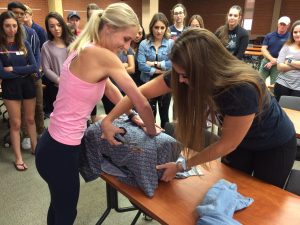
Accordingly, as a general rule, we do not remove impaled objects in the field, if we can avoid it. Rather, we use bulky dressings (a doughnut or pyramid of material shoring up the object) to stabilize it in place for transport.
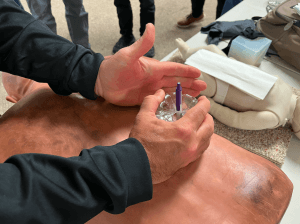
If you don’t have any bulky dressings, you can cut the patient’s shirt and wad it up around the object, taping it in place to accomplish the same objective.

Remember,
“If you can’t do it with duct tape, you’re not using enough duct tape.”
–Dwayne “The Rock” Johnson
Another option I learned from fellow instructor Ian T is cutting off the bottom of a water bottle to shore up the object (again, with a liberal application of tape to the bottle you are using to stabilize). Be careful to ensure that the bottle itself isn’t applying lateral pressure on only one side, rather than equally all-the-way-around, on the object.
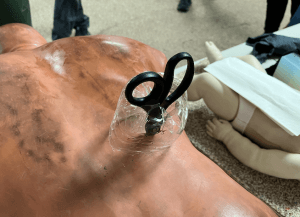
Fixed Object Impalement
If whatever they fell on is stuck to the location (think of rebar sticking out of concrete) you may need to cut it to transport the patient. If that would take two days, you’ll simply have to pull the patient off of it, but be prepared BEFORE YOU MAKE THAT MOVE to control any subsequent bleeding. Don’t pull the patient off, then go fishing around for gauze to pack the wound.
If a person climbing a fence fell, catching the sharp top end of the angle iron fencepost in their armpit, and then instinctively lept up away from the pain and off of it, do NOT stick them back on the impaling object like in a spoofy Adam Sandler mystery movie. Treat it like any other wound.
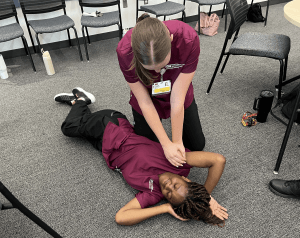
If the hole is bleeding severely but too high up to tourniquet, you would pack the wound up toward the shoulder, where the vessels leading from the heart to the arm are, and then apply pressure over the top of the packed wound, as this nursing student does.
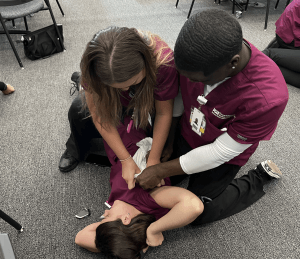
Fill the void left by the formerly impaled fence post, but try not to pack toward the chest, where the lungs are. While the students in this photo may appear to be packing the simulated wound in the direction of the chest (which would be sub-optimal), they are using their legs to prop the patient up to where the wound is more readily packable (which is innovative).
Shortening for Transport
Even if the object is not affixed to the location, you might think of cutting the impaled object, if it is so long it could get jostled or pushed father in during transport.

A Rescuer Gotta Do What a Rescuer Gotta Do
Although it is ALMOST never a good idea, there is no 11th Commandment from the Designer of our bodies that “Thou Shalt Not Remove an Impaled Object in the Field.“ If an Impaled Object is blocking the airway, we absolutely must remove it ASAP.
Also, if you cannot pack a severely bleeding wound because you keep cutting your fingers on the sharp Bowie knife that is impaled therein and causing more damage each time you try, by all means remove it.
Wounded Side Down
Transport the victim with the affected side down, if possible. Gravity will pull blood and other fluids down, so keeping the affected side down means less compromise to the unaffected side. Also, if the impaled object broke any ribs on the way in, transporting the patient with the affected side down will help to splint the ribs against the back seat of your ex-cab.

Objects Impaled in Eyes
. . . are a special situation, because eyes move. You cannot affix the object in place; if you did the outside end would stay put and the inside would stir around like a martini swizzle stick.
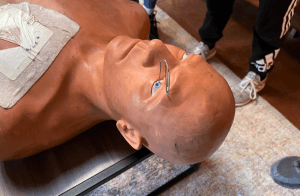
Taping a styrofoam or plastic cup over the eye “blinds” it to keep it from looking around, in and of itself. It allows some movement for the object.
But most people come with two eyes. The other eye will look at things, and they both track together (unless the person has a lazy eye). People look at things subconsciously. It’s a good idea to cover the other eye to keep it from looking around as well.
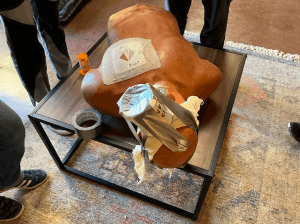
Even if the object is not stuck in the eye, anything on the surface of the eyeball hurts like the dickens. Much of the time, rinsing the eye with copious amounts of water may take care of the issue. If it doesn’t, covering both eyes in a way that won’t grind the object into the eye while enroute to the hospital is probably the way to go.
Make no mistake, objects in the eye can cause loss of eyesight and even blindness, so take them seriously.
—George H, 30 year EMT
